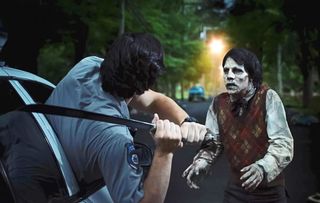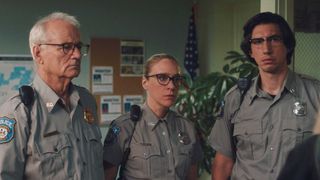The Dead Don’t Die is – in a manner of thinking – Jim Jarmusch’s second zombie film. Technically, Only Lovers Left Alive (2013) is a vampire film, but its central character, the depressively immortal Adam (Tom Hiddleston), lords it over ‘the zombies’, his term for the human population, whose ignorance he resents and whose degradation of Earth he fears.
Adam’s suicidal outlook is connected to some vague catastrophe stalking the horizon. He wonders if the ‘oil wars’ have ended and the ‘water wars’ begun. He and his lover, Eve (of course), played by Tilda Swinton, worry about a summer mushroom growing in the cold dirt of Detroit. Similarly, in the opening moments of The Dead Don’t Die, zombie survivor Hermit Bob (Tom Waits) discovers an unseasonable fungus growing in the forest. ‘You shouldn’t be here,’ he says. What might we conclude from Jarmusch’s self-citation? Perhaps that while The Dead Don’t Die is not a sequel per se, it is the second horror to grow up out of the rhizosphere of his political anxiety.
The Dead Don’t Die is the kind of horror film that fails to horrify, which is not to say it fails as a film.
Set in the town of Centerville, population 738, The Dead Don’t Die is both a nervous portrait of an American small town, with all the Lynchian menace, and a local take on planetary collapse – think Roland Emmerich writ small. Centerville’s welcome sign says it is ‘A Real Nice Place’, and it would be – if it weren’t for some real weird shit going down. The sun won’t set. Watches stop. Pets run away. And, of course, the dead don’t die. ‘This isn’t going to end well,’ repeats officer Ronnie Peterson (Adam Driver) in the face of each new anomaly. Yet there’s nothing the good people of this real nice place can do about it. A field of energy distortion has enveloped the moon – on account of the Earth being ‘off its axis’ on account of the ‘polar fracking’.
Jarmusch has now directed more than twenty films, ensuring that he will always be more than twice as prolific as that other nerd of the Miramax generation, Quentin Tarantino, who has promised to stop at ten. While Tarantino enjoys the status of a must-see showman with a mass audience, Jarmusch has never courted one. The Dead Don’t Die is as close as he’s come: it’s a quirky but palatable genre pic with a fine ensemble cast. Its environmental subtext aligns it with the politically progressive role that Robin Wood long ago afforded horror films. Somewhat conclusively, Jarmusch’s late political impulse – best expressed in The Limits of Control (2009) – offers an antidote to the reactionary revenge fantasies of Tarantino, increasingly stoked by the great yes-man of the box office.

The Dead Don’t Die is the kind of horror film that fails to horrify, which is not to say it fails as a film. The first act, while introducing the plight of Centreville, affords mild comic relief. Casting Iggy Pop as a coffee-loving zombie was clever. Presumably he breezed through make-up. It becomes confused, however, when it takes aim at the very mass audience that Jarmusch has, up until now, never really cared to attract. Billy Wilder famously said that people came to Ace in the Hole expecting a martini and he served up a shot of olive juice. If we expect Jarmusch to swoop us through a comic-horror romp, with icons like Tilda Swinton and Bill Murray slicing ghouls, we shouldn’t be surprised to find the machete swung at us.
Ever since the art of the zombie began – arguably when Zora Neale Hurston photographed Felicia Felix-Mentor staggering through a Haitian churchyard – images of the undead have stood for more than themselves. Viewers refuse their presence. They must represent something instead. Hurston immediately began fantasising about Voodoo poison, elixirs of cemetery dirt and horsehair that could suspend vital signs, allowing for reanimation later. Zombie’s represented a crime of sorcery. White Zombie (1932), Hollywood’s first example of the genre, preserves the context of Afro-Caribbean religion, but makes zombies into factory workers, churned in the machinery of sugar plantations. Today the zombie has been flattened into a ready-made stand-in for the late-capitalist consumer; you know, the kind of person who might want a new pair of jeans or a movie ticket. What’s sad is not becoming a zombie, but what the zombie has come to represent so blandly. Sadder still, Jarmusch doesn’t rethink zombie/consumer logic at all: rather, he commits to it.
The problem with Jarmusch’s zombies isn’t their goofiness, it’s their conceptual insipidity. The film would have us think they are terrible because they’re normal.
Jarmusch’s zombies look cool enough. In fact, it was neat to see him lighten up on the high-cool, ironic profundity and churn out some ghouls. His was always a nerdy cool anyway, trading the stock of literary allusion. Here, Tilda Swinton’s character, Zelda Winston (who looks more Legend of Zelda than Zelda Fitzgerald), even drops a light-hearted Star Wars reference. The problem, then, with Jarmusch’s zombies isn’t their goofiness, it’s their conceptual insipidity. The film would have us think they are terrible because they’re normal. They want to eat candy, drink coffee, connect to Wi-Fi and, if it were set in Australia instead of Pennsylvania, go to Bunnings on the weekend. They even pass up the standard fare of brains and play the mummy–daddy game of nibbling at their victims’ tummies. They don’t want to wipe us out; they want us to join the family. Likewise, this is a film that asks us to join in on the commercial fun but then takes aim at the head.
Fans I know of Jim Jarmusch (I’m one of them) are in the habit of approaching each new release with a stale set of judgements: will this be a ‘return to form’ or a ‘he’s lost the plot’? Whether this indicates a failure of the critic’s imagination or the artist’s is worth debating. For my money, The Dead Don’t Die falls toward the latter. It amuses well but loses the plot even better, ending in a self-induced tangle of unfinished thoughts, tired metaphors, and dumb surprises. The film suffers not from its silliness, nor its desire to make its auteur more popular, but from the failure to take seriously the contradiction which that desire awoke in itself.






